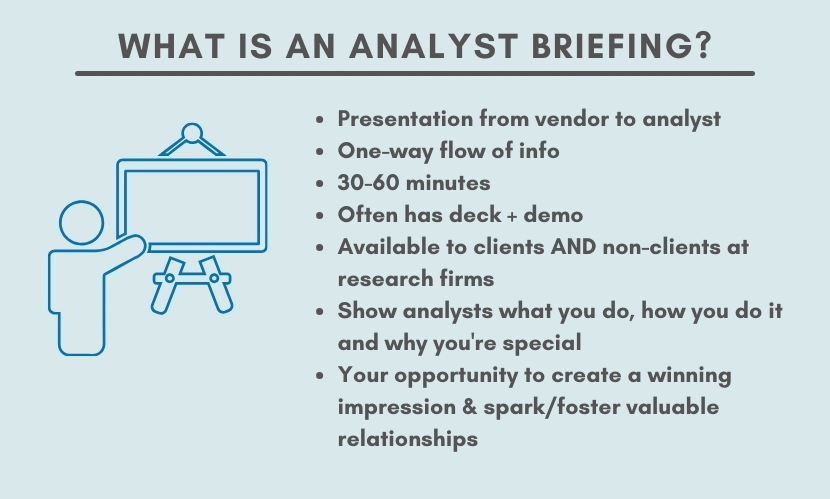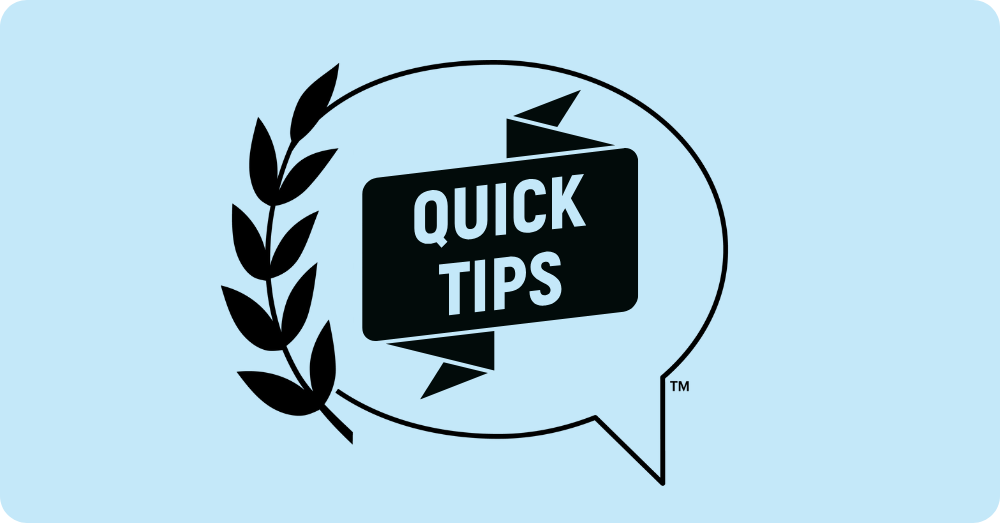If you haven’t done a briefing for one of the research analyst firms, you could be forgiven for imagining it’s a lot like a media interview, or a sales call or an investor presentation. Or maybe you found this post because you did have an analyst briefing, and you treated it like a media interview, sales call or investor presentation… and you want to do better next time.
Research analysts are busy people, and need specific information — so wasting their time (and yours) with anything beyond that can be a serious blunder. For analyst relations (AR) professionals, especially newer ones in the field, it’s worth a few minutes to read about the why, how and what of briefings, and a bit more time to use the advice as a prep guide before you join the call.
At ARInsights, we help AR pros and their companies plan briefings that match their goals, choose the right analysts to brief, prepare for the meetings and nail the content. We’ve seen great briefings that changed companies’ fortunes… as well as some that missed the mark. Below are some best practices and key information to help mark the path through a briefing you can be proud of.
What is an analyst briefing?

An analyst briefing is a 30-minute-to-one-hour live presentation from a vendor to an analyst: a one-way flow of information that’s not intended to be a dialogue. Typically guided by a deck, and often including a demo, briefings serve to inform analysts about topics such as: introducing your company, sharing a new go-to-market strategy, launching a new product, providing a deep-dive into news from your recent user conference (and so on). Briefings make analysts better versed in what you do, how and why you do it, and what makes you different or successful.
Important note: You don’t have to be a client of a research firm to brief their analysts. Non-clients, however, sometimes have more restrictions around the frequency with which they can brief analysts; one-to-two briefings a year with a given analyst is typical for non-clients. That makes it even more important to time your briefing to your biggest news or the right milestone — for example, in the run-up to a report you’d like to be included in or ahead of a conference where you know the analyst will give a presentation on your market.
Why do we brief analysts?
Analysts spend their days turning conversations and data into intelligence that helps buyers buy and helps vendors sell. Simply put, analysts are influential: 92% of B2B buyers say analyst reviews and reports impact their purchase decisions.
In addition, it’s important for vendors to make sure analysts are up-to-speed on their business, offerings, customer successes and more — because analysts use the information and insights provided in a number of ways, including:
In their research, such as vendor comparisons in a major market, trend reports, vendor profiles, market landscapes, etc.
In inquiries with buyers, such as when end-users come to analysts with technology questions and challenges to solve
In various public comments/forums, including media interviews, speaking engagements, webinars, social posts and so on.
Well-planned briefings can help analysts help you. For example, providing a novel case study with replicable results, or a demo of a new feature the market is looking for, can help analysts make valuable contributions to their clients’ (your prospects’) plans, and lead prospects to the value only you can provide. It’s a win for everyone.
What are some briefing to-do’s?
Well-executed and successful briefings not only inform analysts but also can go a long way in fostering positive, productive relationships with those analysts as well. So, it’s important to come ready to maximize your — and the analyst’s — time and make a strong impression.
To that end, be prepared. Think through your briefing goals and the flow of information in advance. Read up on the analyst, and be aware of your company’s history (if any) with them, so your spokespeople can reference coverage, previous interactions, common interests, follow-up items, etc. as appropriate. It’s important to prep internal executives, such as with “briefing books,” so everyone comes to the meeting aligned.
Also, have a slide deck — which you may choose to provide in advance or, alternately, email to the analysts afterward as a leave-behind — to organize the meeting.
“[A] pet peeve was the vendor not having a deck when presenting on a briefing. I attended several briefings where the vendor just wanted to chit-chat about their solution. That’s typically not how vendor briefings are run at Gartner or at other research firms either. Not having a deck was also off-putting for me because you don’t have anything to take with you to glance back at and reference. There are only so many notes you can take during a presentation, right?”
- Former Gartner analyst Julian Tirsu, now director of analyst relations at Dropbox, discussed his analyst days with ARInsights Tweet
So, make a good impression, and show analysts you’ve thought your briefing content through.
What should you cover in a briefing?
What belongs in your briefing deck? This depends, in part, on your briefing topic.
Elias Khnaser, a former Gartner cloud research VP and now chief of research for EK Media Group, told ARInsights: “If it’s a first-time briefing, and the analyst doesn’t know anything about your company or product, I think the deck needs to show who the company is, who the executives are and — if it’s a start-up — who funds it. That lends a lot of credibility. And then talk about the product and positioning. Once you have a relationship, or if you’re with a well-established company, don’t bury the lead in a briefing. Try to get to the point early on in the deck.”
At ARInsights, we advise companies in their decks, and during their briefings, to:
- Establish the narrative early on, so briefings have a clear and logical flow.
- Link the briefing content to the analyst’s interests, to drive value and show you’re prepared.
- Support your position, such as with examples and customer validation.
- Define your competitive set and differentiation: What can you say that others can’t? What makes prospects choose you over others? What resonates most with your prospects?
- Show your direction: What’s next and why?
- Include customer stories and real-world use cases. Clients of the research firm being briefed may choose to include information under NDA… but avoid NDAs if you can, and if you can’t, be very clear about what content is sensitive, and if/when the NDA can be lifted.
- Be visual. Graphics beat text, except in follow-up, so consider a second (more text-driven) version of your deck to be sent as a leave-behind.
- Take note of follow-up items… and follow up on them.
- But most of all, be memorable. Know how you are different and valuable to your customers, and clearly articulate that. Tell the analysts something they haven’t heard before and can use to make their clients more successful. Give analysts a reason to root for your success and show your deep appreciation for your customers with a great story. Include key information that will make analysts remember you at the right time — when your prospects need the help you offer.
What NOT to do during a briefing
Just as adhering to best practices and going the extra mile can set you apart with analysts, committing briefing gaffes can also make you memorable… but not in the way you’d like!
Many of the common don’t-do’s that we’ve listed below are also validated by other experts as pet peeves that get under analysts’ skin.
With that in mind…
- Don’t cite competitive research to analysts. Speaking to Forrester analysts about the market need for your solution? It’s a rookie mistake and a turn-off to show them forecasts and market stats from Gartner, IDC and so on on a slide in your deck.
- Don’t turn your briefing into an inquiry. As discussed, briefings are one-way presentations (vendor → analyst). Inquiries, on the other hand, involve more of a give-and-take, are used to solicit analyst feedback (and as such, typically require more extensive analyst prep) and (unlike briefings) are available to clients only.
“While the analyst isn’t just going to be silent [during a briefing], it’s not really intended to be a two-way conversation… What I’ve seen is that during briefings, some organizations try to introduce who they are, and then they’ll start asking for feedback and input: ‘What do we do here; what do we do there?’ This is where the personality of the analyst will come into play. Some will shut it down immediately and say, ‘Please go ahead and schedule an inquiry on that.’ Others will entertain the questions for a few minutes and then say, ‘Folks, we really need to transition to an inquiry.’ Either way, when companies do this, it’s a bit annoying because it puts the analyst in an uncomfortable position. As we talk about good vs. great AR people, a great one wouldn’t do this.”
- EK Media Group’s Elias Khnaser (previously of Gartner) told ARInsights Tweet
- Don’t dismiss feedback. That all said… there may be instances when you find an analyst to be generous with feedback, especially in a first briefing. Please take this for what it is: free advice from someone who usually charges a fair amount for the information. You might not be able to act on the insight, but it doesn’t make their goodwill gesture less meaningful. One final don’t related to this: don’t take feedback as criticism by default. Most analysts want to be helpful, and if they are offering feedback when they don’t have to, it’s likely because they see an opportunity for you and want you to grab it.
- Don’t indulge in tangents (too much). Follow your analyst’s comments and tangents, but only so far. Don’t derail your briefing because you’ve made a connection. You might only get one chance per year at the overview briefing, but you can propose a follow-up call if they have more than a passing interest in a related question.
- Don’t eat up too much time on intros. Your briefing is likely only 30-45 minutes, so let’s cut to the chase. Elias Khnaser pointed out: “If there’s an analyst relations person on the call, that person can introduce everyone quickly… Let’s not spend 10 minutes on intros. Jump into the subject matter quickly, and get to the point.”
- Don’t use marketing jargon (or only include marketing execs, especially in technical briefings). Julian Tirsu corroborates this and told ARInsights: “You run into problems when it’s just marketing on the line — especially when they don’t understand the scope of the meeting, or they try to sell you that their product is the best product you’ve ever seen. As an analyst… you want to hear more about what the vendor is trying to solve for customers and how they’re tackling certain use cases.”
- Don’t assume that AI-based recorders are A-OK. We’re still in the early days of generative AI and determining appropriate use cases. Before your GenAI-based notetaker makes an appearance in your briefing, clear it with the analyst first. Note: This is often more of a concern in inquiries, where analysts are giving their input. In our annual collection of AR “spooky stories,” Reyne Quackenbush, global head of analyst relations at Thoughtworks, shared why enabling AI notetakers without asking first is a don’t-do!
Make the most of your briefings
With some analysts having more than 1,000 interactions each year — including up to five-to-seven calls each day — there’s a lot of vendor information jostling about in their minds. So, again, be memorable, and make your briefings count!
By following the best practices above, you’re well-positioned to make a good and lasting impression during your briefings. But don’t let the conversation end there. It’s important, of course, to continue building your relationship with the analysts you brief. Thank them for their time, follow up as promised, and keep them in the loop — for example, as recipients of your analyst newsletters or Analyst Portal communications.
ARInsights Services helps you make the most of briefings, so you can inform and show analysts why your business matters — and give them the knowledge and insights to spread the word. Want to learn more or strategize about how to drive the most value from briefings? Get more info about our services at www.arinsights.com/services, or reach out to sales@arinsights.com.




